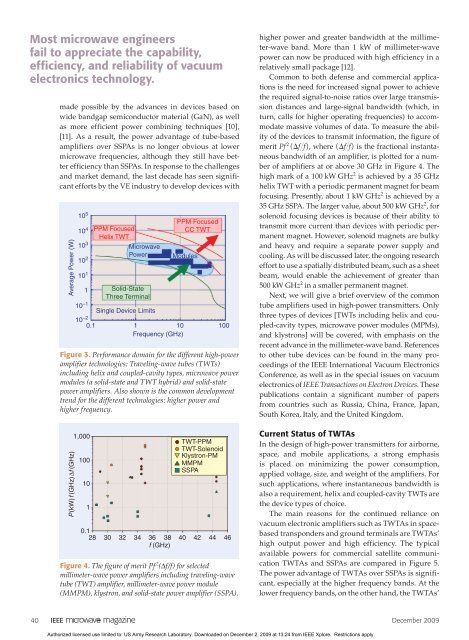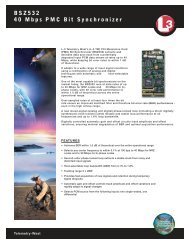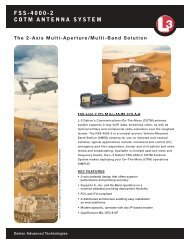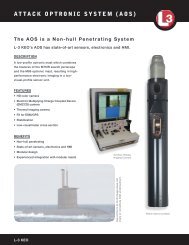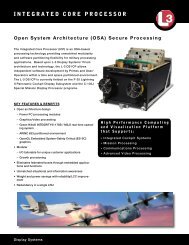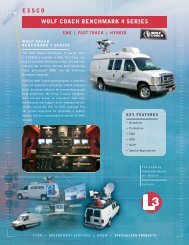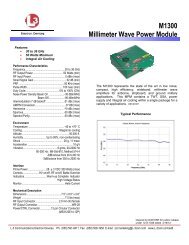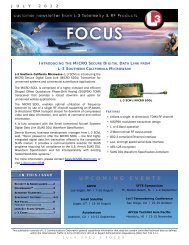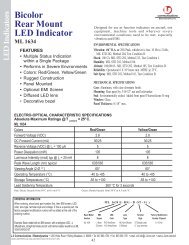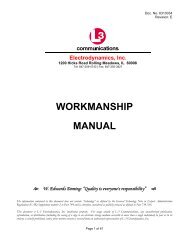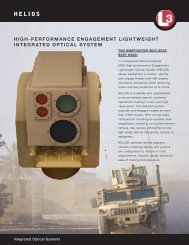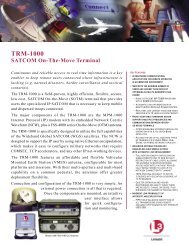Copyright © 2009 IEEE. Reprinted from Microwave Magazine - L-3 ...
Copyright © 2009 IEEE. Reprinted from Microwave Magazine - L-3 ...
Copyright © 2009 IEEE. Reprinted from Microwave Magazine - L-3 ...
Create successful ePaper yourself
Turn your PDF publications into a flip-book with our unique Google optimized e-Paper software.
Most microwave engineersfail to appreciate the capability,efficiency, and reliability of vacuumelectronics technology.made possible by the advances in devices based onwide bandgap semiconductor material (GaN), as wellas more efficient power combining techniques [10],[11]. As a result, the power advantage of tube-basedamplifiers over SSPAs is no longer obvious at lowermicrowave frequencies, although they still have betterefficiency than SSPAs. In response to the challengesand market demand, the last decade has seen significantefforts by the VE industry to develop devices withAverage Power (W)10 510 410 310 210 1PPM FocusedHelix TWT<strong>Microwave</strong>PowerPPM FocusedCC TWTModules1 Solid-StateThree Terminal10 –110 –2 0.1Single Device Limits1 10 100Frequency (GHz)Figure 3. Performance domain for the different high-poweramplifier technologies: Traveling-wave tubes (TWTs)including helix and coupled-cavity types, microwave powermodules (a solid-state and TWT hybrid) and solid-statepower amplifiers. Also shown is the common developmenttrend for the different technologies: higher power andhigher frequency.P(kW)f (GHz)Δf (GHz)1,000100101TWT-PPMTWT-SolenoidKlystron-PMMMPMSSPA0.128 30 32 34 36 38 40 42 44 46f (GHz)Figure 4. The figure of merit Pf 2 (Δf/f) for selectedmillimeter-wave power amplifiers including traveling-wavetube (TWT) amplifier, millimeter-wave power module(MMPM), klystron, and solid-state power amplifier (SSPA).higher power and greater bandwidth at the millimeter-waveband. More than 1 kW of millimeter-wavepower can now be produced with high efficiency in arelatively small package [12].Common to both defense and commercial applicationsis the need for increased signal power to achievethe required signal-to-noise ratios over large transmissiondistances and large-signal bandwidth (which, inturn, calls for higher operating frequencies) to accommodatemassive volumes of data. To measure the abilityof the devices to transmit information, the figure ofmerit Pf 2 1Df@f2, where 1Df@f2 is the fractional instantaneousbandwidth of an amplifier, is plotted for a numberof amplifiers at or above 30 GHz in Figure 4. Thehigh mark of a 100 kW GHz 2 is achieved by a 35 GHzhelix TWT with a periodic permanent magnet for beamfocusing. Presently, about 1 kW GHz 2 is achieved by a35 GHz SSPA. The larger value, about 500 kW GHz 2 , forsolenoid focusing devices is because of their ability totransmit more current than devices with periodic permanentmagnet. However, solenoid magnets are bulkyand heavy and require a separate power supply andcooling. As will be discussed later, the ongoing researcheffort to use a spatially distributed beam, such as a sheetbeam, would enable the achievement of greater than500 kW GHz 2 in a smaller permanent magnet.Next, we will give a brief overview of the commontube amplifiers used in high-power transmitters. Onlythree types of devices [TWTs including helix and coupled-cavitytypes, microwave power modules (MPMs),and klystrons] will be covered, with emphasis on therecent advance in the millimeter-wave band. Referencesto other tube devices can be found in the many proceedingsof the <strong>IEEE</strong> International Vacuum ElectronicsConference, as well as in the special issues on vacuumelectronics of <strong>IEEE</strong> Transactions on Electron Devices. Thesepublications contain a significant number of papers<strong>from</strong> countries such as Russia, China, France, Japan,South Korea, Italy, and the United Kingdom.Current Status of TWTAsIn the design of high-power transmitters for airborne,space, and mobile applications, a strong emphasisis placed on minimizing the power consumption,applied voltage, size, and weight of the amplifiers. Forsuch applications, where instantaneous bandwidth isalso a requirement, helix and coupled-cavity TWTs arethe device types of choice.The main reasons for the continued reliance onvacuum electronic amplifiers such as TWTAs in spacebasedtransponders and ground terminals are TWTAs’high output power and high efficiency. The typicalavailable powers for commercial satellite communicationTWTAs and SSPAs are compared in Figure 5.The power advantage of TWTAs over SSPAs is significant,especially at the higher frequency bands. At thelower frequency bands, on the other hand, the TWTAs’40 December <strong>2009</strong>Authorized licensed use limited to: US Army Research Laboratory. Downloaded on December 2, <strong>2009</strong> at 13:24 <strong>from</strong> <strong>IEEE</strong> Xplore. Restrictions apply.


